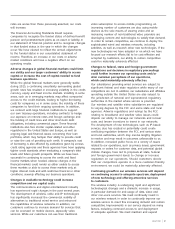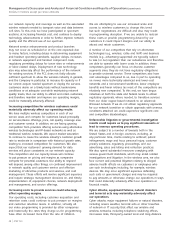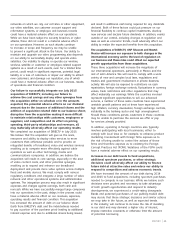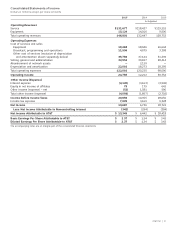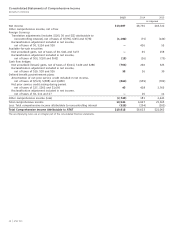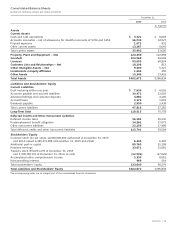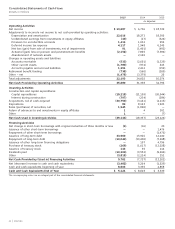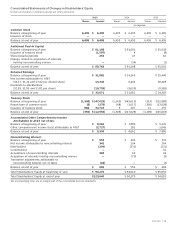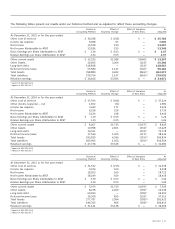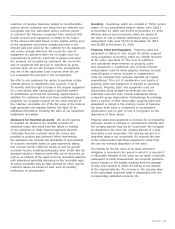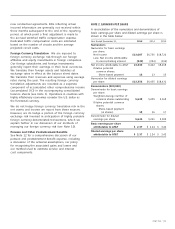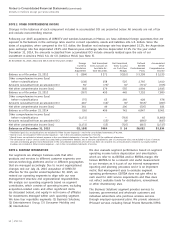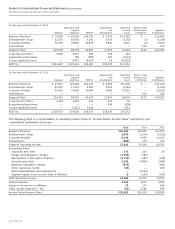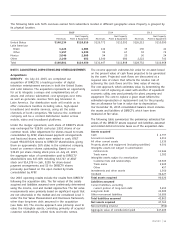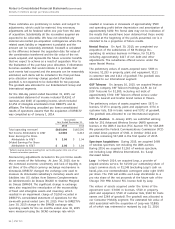AT&T Wireless 2015 Annual Report Download - page 48
Download and view the complete annual report
Please find page 48 of the 2015 AT&T Wireless annual report below. You can navigate through the pages in the report by either clicking on the pages listed below, or by using the keyword search tool below to find specific information within the annual report.
46
|
AT&T INC.
Notes to Consolidated Financial Statements
Dollars in millions except per share amounts
enhances comparability to other companies in the industry.
This change in accounting did not have an impact on our
wireless activities, due to the absence of these types of
expenses in those business activities.
The cumulative effect of the change on Retained Earnings as
of January 1, 2013, was an increase of approximately $2,959
on our consolidated balance sheet. This change did not have
an impact on cash provided by or used in operations for any
period presented.
New Accounting Standards
Long-Term Debt and Debt Issuance Costs In April 2015,
the Financial Accounting Standards Board (FASB) issued
Accounting Standards Update (ASU) No. 2015-03, “Interest
– Imputation of Interest: Simplifying the Presentation of
Debt Issuance Costs” (ASU 2015-03), which resulted in the
reclassification of debt issuance costs from “Other Assets”
to inclusion as a reduction of our reportable “Long-Term
Debt” balance on our consolidated balance sheets. Since
ASU 2015-03 does not address deferred issuance costs for
line-of-credit arrangements, the FASB issued ASU No. 2015-15,
“Interest – Imputation of Interest: Presentation and
Subsequent Measurement of Debt Issuance Costs Associated
with Line-of-Credit Arrangements” (ASU 2015-15), in
August 2015. ASU 2015-15 allows a company to defer debt
issuance costs associated with line-of-credit arrangements,
including arrangements with no outstanding borrowings,
classify them as an asset, and amortize them over the term
of the arrangements. We elected to adopt ASU 2015-03 early,
with full retrospective application as required by the guidance,
and ASU 2015-15, which was effective immediately. These
standards did not have a material impact on our consolidated
balance sheets and had no impact on our cash flows
provided by or used in operations for any period presented.
Business Combinations In September 2015, the FASB
issued ASU No. 2015-16, “Business Combinations –
Simplifying the Accounting for Measurement-Period
Adjustments” (ASU 2015-16), which results in the ability
to recognize, in current period earnings, any changes in
provisional amounts during the measurement period after
the closing of an acquisition, instead of restating prior
periods for these changes. We elected to adopt ASU
2015-16 early, which had no impact on our consolidated
balance sheet as of December 31, 2015, or our consolidated
operating results and cash flows for the year ended.
Deferred Income Taxes and Liabilities In November 2015,
the FASB issued ASU No. 2015-17, “Income Taxes
(Topic 740) – Balance Sheet Classification of Deferred Taxes”
(ASU 2015-17), which requires companies report their
deferred tax liabilities and deferred tax assets, together as
a single noncurrent item on their classified balance sheets.
We elected to adopt ASU 2015-17 early, and applied it
retrospectively as allowed by the standard. Our adoption
of ASU 2015-17 did not have a material impact on our
consolidated balance sheets and had no impact on our cash
provided by or used in operations for any period presented.
NOTE 1. SUMMARY OF SIGNIFICANT ACCOUNTING POLICIES
Basis of Presentation Throughout this document, AT&T Inc.
is referred to as “AT&T,” “we” or the “Company.” The
consolidated financial statements include the accounts of
the Company and our majority-owned subsidiaries and
affiliates, including the results of DIRECTV and wireless
properties in Mexico for the period from acquisition through
December 31, 2015. Our subsidiaries and affiliates operate
in the communications and digital entertainment services
industry, providing services and equipment that deliver voice,
video and broadband services domestically and internationally.
All significant intercompany transactions are eliminated in the
consolidation process. Investments in less than majority-
owned subsidiaries and partnerships where we have
significant influence are accounted for under the equity
method. Earnings from certain investments accounted for
using the equity method are included for periods ended
within up to one quarter of our period end. We also recorded
our proportionate share of our equity method investees’
other comprehensive income (OCI) items, including actuarial
gains and losses on pension and other postretirement benefit
obligations and cumulative translation adjustments.
The preparation of financial statements in conformity with
U.S. generally accepted accounting principles (GAAP) requires
management to make estimates and assumptions that
affect the amounts reported in the financial statements
and accompanying notes, including estimates of probable
losses and expenses. Actual results could differ from
those estimates. Certain amounts have been reclassified to
conform to the current period’s presentation, including our
presentation of “Equipment” and “Broadcast, programming
and operations” costs separately from other cost of services
in the consolidated statements of income.
Customer Fulfillment Costs In August 2015, with
our acquisition of DIRECTV, we announced a change in
accounting for customer set-up and installation costs.
Historically we have followed an accounting policy of
deferring customer set-up and installation costs only to
the extent of deferred revenues recorded for upfront fees
(e.g., activation charges), and to expense any costs that
exceed deferred revenues. After discussing this change with
the Securities and Exchange Commission, we changed our
accounting to a preferable method of capitalizing these
costs and amortizing them over the expected economic life
of the customer relationship of approximately four years,
subject to an assessment of the recoverability of such
costs. This change in accounting principle impacts video,
broadband Internet and wireline voice services and is
considered preferable in that it provides an accurate
reflection of assets (i.e., the contractual customer
relationship obtained through the set-up and installation)
generated by those specific business activities. Our new
accounting method is more comparable with the accounting
method used in the cable entertainment industry. With our
acquisition of DIRECTV, changing to this accounting method



